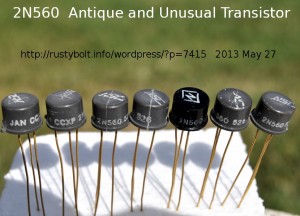
These 2N560 transistors are the only ones I’ve seen with plastic for the standard TO-5 case, which is usually metal. The size and shape is identical, even down to the little tab that sticks out. According to the Motorola Semiconductor Data Book (1969), the specifications are:
2N560 Silicon NPN
Pd@25 deg. C (ambient): 500 mW — Tj: 150 deg. C
Vces: 60 Volts hFE: 20 min @ 100 mA
Vce(sat): 0.5V @ 10 mA
And there’s nothing else given. The NSC on the top apparently means National Semiconductor Company; the black one has a different logo, but I assume that it’s the same company. The JAN CCXP before the part number means that it has been tested according to military specifications. I measured the gains of the transistors and they varied from a low of 19 to a high of 93, with some around 30 to 50. My guess is that time has taken its toll on some of them and caused some deterioration in the parameters. I checked the specs for some other early silicon transistors, and it seems that this 2N560 is similar to the 2N335 types that were made by Texas Instruments back then and were used by some military equipment.
In the early 1960s most of the transistors being made were germanium, and silicon transistors were much more difficult to manufacture. But the silicons were much faster than the germaniums, so eventually the germaniums were replaced by silicon and it’s very rare to see any germanium transistors used today. But even though this transistor is silicon, the transistors made today are far better, especially when it comes to the current gain. A typical transistor made today has a current gain more than ten times higher, 250 to 400 or even more. And today’s transistors can go to more than ten times higher in frequency, too. And with automated equipment, today’s transistors are much, much cheaper, probably a hundred times less expensive than back then. The cost of a military grade transistor was much higher than a commercial one, so I would imagine that these 2N560 transistors could have cost tens of dollars apiece.